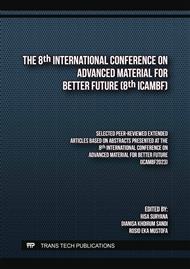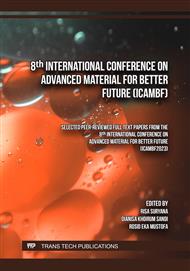[1]
Y. Zhang, Y. Huang, Y.F. Ding, Y.R. Zheng and W.K. Dong, Synthesis, crystal structure, properties, and theoretical studies of novel tetra-nuclear copper (II) salamo-like complex containing four-and five-coordinated geometries, Journal of Molecular Structure. (2023).
DOI: 10.1016/j.molstruc.2023.136051
Google Scholar
[2]
S. Mukherjee, C.K. Pal, M. Kotakonda, M. Joshi, M. Shit, P. Ghosh and B. Biswas, Solvent induced distortion in a square planar copper (II) complex containing an azo-functionalized Schiff base: Synthesis, crystal structure, in-vitro fungicidal and anti-proliferative, and catecholase activity, Journal of Molecular Structure. 1245 (2021) 131057.
DOI: 10.1016/j.molstruc.2021.131057
Google Scholar
[3]
Chandra, S. Vananda and S. Kumar, Synthesis, spectroscopic, anticancer, antibacterial and antifungal studies of Ni(II) and Cu(II) complexes with hydrazine carboxamide, 2-[3-methyl-2-thienyl methylene], Spectrochimica Acta Part A: Molecular and Biomolecular Spectroscopy. 135 (2015) 356-363.
DOI: 10.1016/j.saa.2014.06.143
Google Scholar
[4]
M. Shebl, O.M. Adly, H.F. El-Shafiy, S.M. Khalil, A. Taha and M.A. Mahdi, Structural variety of mono-and binuclear transition metal complexes of 3-[(2-hydroxy-benzylidene)-hydrazono]-1-(2-hydroxyphenyl)-butan-1-one: synthesis, spectral, thermal, molecular modeling, antimicrobial and antitumor studies, Journal of Molecular Structure. 1134 (2017) 649-660.
DOI: 10.1016/j.molstruc.2017.01.012
Google Scholar
[5]
S. Sobhani, M. Pordel and S.A. Beyramabadi, Design, synthesis, spectral, antibacterial activities and quantum chemical calculations of new Cu (II) complexes of heterocyclic ligands, Journal of Molecular Structure. 1175 (2019) 677-685.
DOI: 10.1016/j.molstruc.2018.08.034
Google Scholar
[6]
H. Nurdiana, N.A.N. Azizah, S.D. Marliyana, S.B. Rahardjo, S. Wahyuningsih, D.M. Widjonarko and E. Pramono, Synthesis and characterization of Cu (II) and Co (II) complexes with m-phenylendiamine ligand, Rasayan Journal of Chemistry. 16 (2023) 2.
DOI: 10.31788/rjc.2023.1628090
Google Scholar
[7]
S. Yousuf, F. Arjmand and S. Tabassum, Design, synthesis, ligand's scaffold variation and structure elucidation of Cu (II) complexes; in vitro dna binding, morphological studies and their anticancer activity, Polyhedron. 209 (2021).
DOI: 10.1016/j.poly.2021.115450
Google Scholar
[8]
S.N. Lyubchenko, I.N. Shcherbakov, Y.P. Tupolova, L.D. Popov, S.I. Levchenkov, A.N. Morozov, S.A. Borodkin, V.A. Lazarenko, V.N. Khrustalev, Y.V. Zubavichus and V.V. Minin, Anion mediated switching from mono-to polymer structure in copper (II) complexes with 4,6-dimethylpyrimidinylhydrazone 1-phenyl-3-methyl-4-formylpyrazol-5-one, Inorganica Chimica Acta. (2020) 502-515.
DOI: 10.1016/j.ica.2019.119284
Google Scholar
[9]
E. Firinci, Copper (II) complexes with barbiturate derivatives: synthesis characterization and catalytic applications. Polyhedron. 164 (2019) 132-137.
DOI: 10.1016/j.poly.2019.02.044
Google Scholar
[10]
A.M. Fahim, H.S. Magar and N.H. Mahmoud, Synthesis, antimicrobial, antitumor activity, docking simulation, theoretical studies, and electrochemical analysis of novel Cd (II), Co (II), Cu (II) and Fe (III) complexes containing barbituric moiety, Applied Organometallic Chemistry. 37 (2023).
DOI: 10.1002/aoc.7023
Google Scholar
[11]
M.S. Refat and T. Sharshar, infrared, raman, 1H NMR, thermal and positron annihilation lifetime studies of Pb (II), Sn (II), Sb (III), Bi (III)-barbital complexes, Journal of Molecular Structure. (2012) 140-146.
DOI: 10.1016/j.molstruc.2012.02.047
Google Scholar
[12]
M. M. Fahad, N. Shafiq, U. Arshad and A.J. Radh, As antimicrobial agents: synthesis, structural characterization and molecular docking study of barbituric acid derivatives from phenobarbital, Research Square. (2021).
DOI: 10.21203/rs.3.rs-1019035/v1
Google Scholar
[13]
M.A. Mahmoud, A.M. Abbas, S.A. Zaitone, A.M. Ammar, and S.A. Sallam, Copper (II) ternary complexes with gabapentin and neurotransmitters as antiepileptic drug, Journal of Molecular Structure. 1180 (2019) 861-877.
DOI: 10.1016/j.molstruc.2018.12.032
Google Scholar
[14]
N.S.M. Alwi, M.A. Hamali, A N. Rosnizam, A.L.M. Low, A. El Hassane, A.A. Nassar, and A.M. Tajuddin, Crystallographic, antibacterial, and in silico studies of Ni (II) and Cu (II) schiff base complexes derived from 2-acetylpyridine, Inorganica Chimica Acta. 558 (2023) 121742.
DOI: 10.1016/j.ica.2023.121742
Google Scholar



